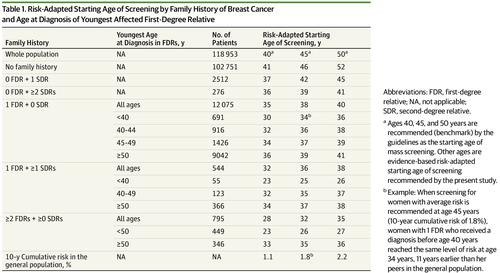当前位置:
X-MOL 学术
›
JAMA Oncol.
›
论文详情
Our official English website, www.x-mol.net, welcomes your feedback! (Note: you will need to create a separate account there.)
Risk-Adapted Starting Age of Screening for Relatives of Patients With Breast Cancer.
JAMA Oncology ( IF 28.4 ) Pub Date : 2019-11-14 , DOI: 10.1001/jamaoncol.2019.3876 Trasias Mukama 1, 2, 3 , Elham Kharazmi 1, 4 , Xing Xu 1, 2 , Kristina Sundquist 4, 5, 6 , Jan Sundquist 4, 5, 6 , Hermann Brenner 1, 7, 8 , Mahdi Fallah 1, 4
JAMA Oncology ( IF 28.4 ) Pub Date : 2019-11-14 , DOI: 10.1001/jamaoncol.2019.3876 Trasias Mukama 1, 2, 3 , Elham Kharazmi 1, 4 , Xing Xu 1, 2 , Kristina Sundquist 4, 5, 6 , Jan Sundquist 4, 5, 6 , Hermann Brenner 1, 7, 8 , Mahdi Fallah 1, 4
Affiliation

|
Importance
Breast cancer screening guidelines acknowledge the need for earlier screening for women at increased risk but provide limited guidance for women with a family history of breast cancer. A risk-adapted starting age of screening for relatives of patients with breast cancer may help supplement current screening guidelines.
Objective
To identify the risk-adapted starting age of breast cancer screening on the basis of a woman's detailed family history.
Design, Setting, and Participants
This nationwide cohort study analyzed data recorded in the Swedish family-cancer data sets. All women born from 1932 onward and with at least 1 known first-degree relative (FDR) were included (N = 5 099 172). Data from January 1, 1958, to December 31, 2015, were collected. Data were analyzed from October 1, 2017, to March 31, 2019.
Exposures
Family history of breast cancer in FDRs and second-degree relatives (SDRs).
Main Outcomes and Measures
Primary invasive breast cancer diagnosis and the age at which women with different constellations of family history attained the risk level at which breast screening is usually recommended.
Results
Of the 5 099 172 women included in the study, 118 953 (2.3%) received a diagnosis of primary invasive breast cancer. A total of 102 751 women (86.4%; mean [SD] age at diagnosis, 55.9 [11.1] years) did not have family history of breast cancer in FDRs and SDRs at the time of their diagnosis. Risk-adapted starting age of breast cancer screening varied by number of FDRs and SDRs with breast cancer diagnosis and the age at diagnosis of the FDRs. For example, for screening recommendation at age 50 years for the general population (2.2% 10-year cumulative risk), women with multiple affected FDRs, with the youngest affected relative receiving a diagnosis before age 50 years, reached the benchmark risk level at age 27 years. When the youngest relative received a diagnosis after age 50 years, however, this risk level was attained at age 36 years.
Conclusions and Relevance
This study identifies possible risk-based starting ages for breast cancer screening based on population-based registers. These results may serve as high-quality evidence to supplement current screening guidelines for relatives of patients with breast cancer.
中文翻译:

乳腺癌患者亲属的风险适应筛查起始年龄。
重要性 乳腺癌筛查指南承认需要对高危女性进行早期筛查,但对有乳腺癌家族史的女性提供的指导有限。对乳腺癌患者亲属进行风险适应筛查的起始年龄可能有助于补充当前的筛查指南。目的根据女性详细的家族史确定乳腺癌筛查的风险适应起始年龄。设计、环境和参与者 这项全国性队列研究分析了瑞典家庭癌症数据集中记录的数据。包括从 1932 年以后出生且至少有 1 个已知一级亲属 (FDR) 的所有女性 (N = 5 099 172)。收集了 1958 年 1 月 1 日至 2015 年 12 月 31 日的数据。数据分析时间为 2017 年 10 月 1 日至 2019 年 3 月 31 日。FDR 和二级亲属 (SDR) 中的乳腺癌家族史。主要结果和措施 原发性浸润性乳腺癌诊断和具有不同家族史的女性达到通常建议进行乳房筛查的风险水平的年龄。结果 在纳入研究的 5 099 172 名女性中,118 953 人(2.3%)被诊断为原发性浸润性乳腺癌。共有 102 751 名女性(86.4%;诊断时的平均 [SD] 年龄,55.9 [11.1] 岁)在诊断时在 FDR 和 SDR 中没有乳腺癌家族史。乳腺癌筛查的风险适应起始年龄因诊断为乳腺癌的 FDR 和 SDR 的数量以及诊断 FDR 的年龄而异。例如,对于一般人群的 50 岁筛查建议 (2. 2% 10 年累积风险),患有多个受累 FDR 的女性,最年轻的受累亲属在 50 岁之前接受诊断,在 27 岁时达到基准风险水平。然而,当最年轻的亲属在 50 岁后接受诊断时,这一风险水平在 36 岁时达到。结论和相关性 本研究根据基于人群的登记确定可能的基于风险的乳腺癌筛查起始年龄。这些结果可以作为高质量的证据来补充目前针对乳腺癌患者亲属的筛查指南。这一风险水平在 36 岁时达到。结论和相关性 本研究根据基于人群的登记确定可能的基于风险的乳腺癌筛查起始年龄。这些结果可以作为高质量的证据来补充目前针对乳腺癌患者亲属的筛查指南。这一风险水平在 36 岁时达到。结论和相关性 本研究根据基于人群的登记确定可能的基于风险的乳腺癌筛查起始年龄。这些结果可以作为高质量的证据来补充目前针对乳腺癌患者亲属的筛查指南。
更新日期:2020-01-09
中文翻译:

乳腺癌患者亲属的风险适应筛查起始年龄。
重要性 乳腺癌筛查指南承认需要对高危女性进行早期筛查,但对有乳腺癌家族史的女性提供的指导有限。对乳腺癌患者亲属进行风险适应筛查的起始年龄可能有助于补充当前的筛查指南。目的根据女性详细的家族史确定乳腺癌筛查的风险适应起始年龄。设计、环境和参与者 这项全国性队列研究分析了瑞典家庭癌症数据集中记录的数据。包括从 1932 年以后出生且至少有 1 个已知一级亲属 (FDR) 的所有女性 (N = 5 099 172)。收集了 1958 年 1 月 1 日至 2015 年 12 月 31 日的数据。数据分析时间为 2017 年 10 月 1 日至 2019 年 3 月 31 日。FDR 和二级亲属 (SDR) 中的乳腺癌家族史。主要结果和措施 原发性浸润性乳腺癌诊断和具有不同家族史的女性达到通常建议进行乳房筛查的风险水平的年龄。结果 在纳入研究的 5 099 172 名女性中,118 953 人(2.3%)被诊断为原发性浸润性乳腺癌。共有 102 751 名女性(86.4%;诊断时的平均 [SD] 年龄,55.9 [11.1] 岁)在诊断时在 FDR 和 SDR 中没有乳腺癌家族史。乳腺癌筛查的风险适应起始年龄因诊断为乳腺癌的 FDR 和 SDR 的数量以及诊断 FDR 的年龄而异。例如,对于一般人群的 50 岁筛查建议 (2. 2% 10 年累积风险),患有多个受累 FDR 的女性,最年轻的受累亲属在 50 岁之前接受诊断,在 27 岁时达到基准风险水平。然而,当最年轻的亲属在 50 岁后接受诊断时,这一风险水平在 36 岁时达到。结论和相关性 本研究根据基于人群的登记确定可能的基于风险的乳腺癌筛查起始年龄。这些结果可以作为高质量的证据来补充目前针对乳腺癌患者亲属的筛查指南。这一风险水平在 36 岁时达到。结论和相关性 本研究根据基于人群的登记确定可能的基于风险的乳腺癌筛查起始年龄。这些结果可以作为高质量的证据来补充目前针对乳腺癌患者亲属的筛查指南。这一风险水平在 36 岁时达到。结论和相关性 本研究根据基于人群的登记确定可能的基于风险的乳腺癌筛查起始年龄。这些结果可以作为高质量的证据来补充目前针对乳腺癌患者亲属的筛查指南。



























 京公网安备 11010802027423号
京公网安备 11010802027423号